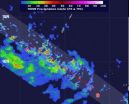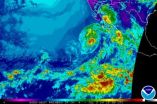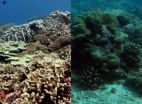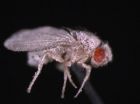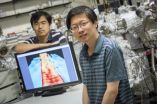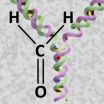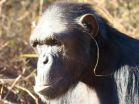(Press-News.org) Powerful thunderstorms in some areas of newborn Tropical Depression 08W in the Northwestern Pacific Ocean were dropping heavy rainfall on July 3 as NASA's Tropical Rainfall Measuring Mission (TRMM) satellite passed overhead.
The eighth depression of the Northwestern Pacific Ocean season formed on July 3 at 0900 UTC (5 a.m. EDT). It was located near 10.0 north latitude and 144.3 east longitude about 240 nautical miles south of Andersen Air Force Base, Guam. Tropical Depression 08W or TD08W had maximum sustained winds near 30 knots (34.5 mph/55.5 kph) and it was moving to the west-northwestward at 14 knots (16.1 mph/25.9 kph).
NASA's TRMM satellite passed over TD08W on July 3 at 0851 UTC (4:51 a.m. EDT) and captured rainfall data on the storm. Some thunderstorms were as high as 9.3 miles (15 km) indicating they were "hot towers." NASA research has shown that whenever hot towers are present a storm will usually strengthen within 6 hours. Those areas also indicated heavy rainfall, where rain rates were about 2 inches (50 mm) per hour. TRMM showed that strong bands of thunderstorms were wrapping into the center of the low-level center. Additional satellite data showed that TD08W's center appeared somewhat elongated.
The Joint Typhoon Warning Center of JTWC expects TD08W to strengthen into a typhoon on July 6, after it passes to the west of Guam. JTWC forecasters then expect the typhoon to move near the Japanese islands of Kadena, Oshima and Amami by July 7 or 8.
INFORMATION:
NASA sees rainfall in newborn Tropical Depression 8W
2014-07-03
ELSE PRESS RELEASES FROM THIS DATE:
Safer, cheaper building blocks for future anti-HIV and cancer drugs
2014-07-03
A team of researchers from KU Leuven, in Belgium, has developed an economical, reliable and heavy metal-free chemical reaction that yields fully functional 1,2,3-triazoles. Triazoles are chemical compounds that can be used as building blocks for more complex chemical compounds, including pharmaceutical drugs.
Leveraging the compound's surprisingly stable structure, drug developers have successfully used 1,2,3-triazoles as building blocks in various anti-HIV, anti-cancer and anti-bacterial drugs. But efforts to synthesize the compound have been hampered by one serious ...
Tropical Storm Douglas weakening in the eastern Pacific
2014-07-03
Tropical Storm Douglas is on a weakening trend, according to the National Hurricane Center, and satellite imagery showed that the storm appeared more elongated on July 3.
NOAA's Geostationary Operational Environmental Satellite or GOES-West satellite captured visible data on Douglas just after sunrise on July 3 at 13:15 UTC (9:15 a.m. EDT). The data from GOES-West was made into an image at NASA/NOAA's GOES Project at the NASA Goddard Space Flight Center in Greenbelt, Md.
Forecaster Stewart at the National Hurricane Center cited that Douglas' thunderstorm activity had ...
Rethinking the reef
2014-07-03
A new study by biologists at San Diego State University and Scripps Institution of Oceanography shows that inhabited coral islands that engage in commercial fishing dramatically alter their nearby reef ecosystems, disturbing the microbes, corals, algae and fish that call the reef home.
The study's lead author, Linda Wegley Kelly, is a postdoctoral scholar in the lab of SDSU virologist Forest Rohwer.
For the study, she looked at seawater samples collected from the surfaces of reefs surrounding all 11 of the Line Islands, a chain of atolls in the central Pacific Ocean. ...
Fruit fly immunity fails with fungus after (space)flight
2014-07-03
Before you swat away the next fruit fly, consider instead just how similar its biological complexities are to our own. In a study published in PLOS ONE, researchers led by Deborah Kimbrell, Ph.D., at the University of California, Davis (UC Davis) and their collaborators, studied how microorganisms may alter fruit flies' immunity in space and in hypergravity, or increased gravity. The article is titled "Toll Mediated Infection Response Is Altered by Gravity and Spaceflight in Drosophila."
This study suggests that having normal gravity or hypergravity on the space station ...
Drug shows promise for effectively treating metabolic syndrome
2014-07-03
(SALT LAKE CITY)—University of Utah researchers have discovered that an enzyme involved in intracellular signaling plays a crucial role in developing metabolic syndrome, a finding that has a U of U spinoff company developing a drug to potentially treat the condition.
The researchers, led by Jared Rutter, Ph.D., professor of biochemistry, hope to begin human clinical trials of a drug in the next couple of years.
"The approved drug therapies do not treat or prevent this condition in most people," says Rutter, senior author of a study describing the research published ...
With 'ribbons' of graphene, width matters
2014-07-03
MILWAUKEE – Using graphene ribbons of unimaginably small widths – just several atoms across – a group of researchers at the University of Wisconsin-Milwaukee (UWM) has found a novel way to "tune" the wonder material, causing the extremely efficient conductor of electricity to act as a semiconductor.
In principle, their method for producing these narrow ribbons – at a width roughly equal to the diameter of a strand of human DNA – and manipulating the ribbons' electrical conductivity could be used to produce nano-devices.
Graphene, a one-atom-thick sheet of carbon atoms, ...
Bone marrow fat tissue secretes hormone that helps body stay healthy
2014-07-03
ANN ARBOR, Mich. — It has been known for its flavorful addition to soups and as a delicacy for dogs but bone marrow fat may also have untapped health benefits, new research finds.
A University of Michigan-led study shows that the fat tissue in bone marrow is a significant source of the hormone adiponectin, which helps maintain insulin sensitivity, break down fat, and has been linked to decreased risk of cardiovascular disease, diabetes, and obesity-associated cancers. The findings appear in today's online-ahead-of-print issue of Cell Metabolism.
Bone marrow adipose ...
NASA sees Hurricane Arthur's cloud-covered eye
2014-07-03
When NASA's Aqua satellite passed over Tropical Storm Arthur on July 2 at 2:50 p.m. EDT on July 2, it saw a cloud-covered eye as the storm was on the way to becoming a hurricane.
This visible image of Tropical Storm Arthur was captured by the Moderate Resolution Imaging Spectroradiometer or MODIS instrument that flies aboard NASA's Aqua satellite. Arthur's center was over the Atlantic Ocean and east of Florida's northeast coast. By 5 a.m. EDT on July 3, Arthur's eye had formed but remained cloud covered even as the storm hit hurricane-strength with maximum sustained ...
Cellular defence against fatal associations between proteins and DNA
2014-07-03
This news release is available in German.
DNA - the carrier of genetic information - is constantly threatened by damage originating from exogenous and endogenous sources. Very special DNA lesions are DNA-protein crosslinks - proteins covalently linked to DNA. So far hardly anything was known about repair mechanisms specifically targeting DNA-protein crosslinks. Stefan Jentsch's team at the Max Planck Institute of Biochemistry in Martinsried, Germany, now discovered a protease that is able to chop down the protein component of DNA-protein crosslinks, thereby enabling ...
'Grass-in-the-ear' technique sets new trend in chimp etiquette
2014-07-03
Chimpanzees are copycats and, in the process, they form new traditions that are often particular to only one specific group of these primates. Such are the findings of an international group of scientists, who waded through over 700 hours of video footage to understand how it came about that one chimpanzee stuck a piece of grass in her ear and started a new trend, and others soon followed suit. The findings of the study, led by Edwin van Leeuwen of the Max Planck Institute for Psycholinguistics in The Netherlands, are published in Springer's journal Animal Cognition.
In ...
